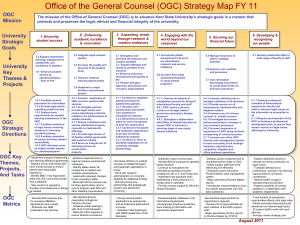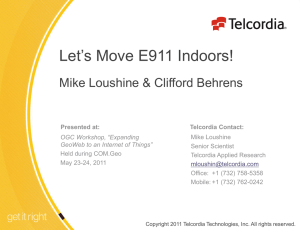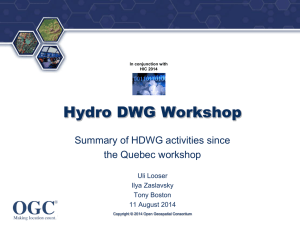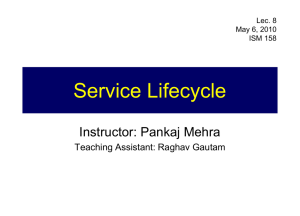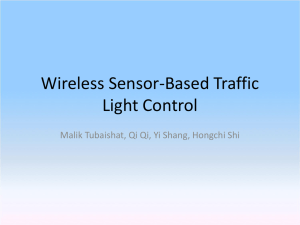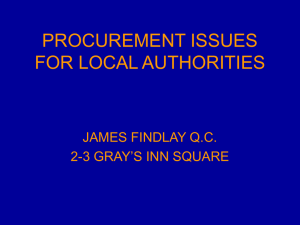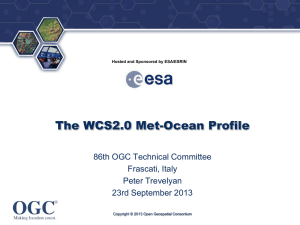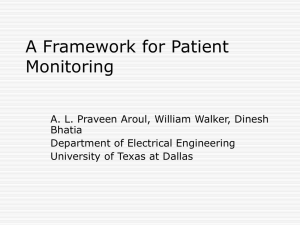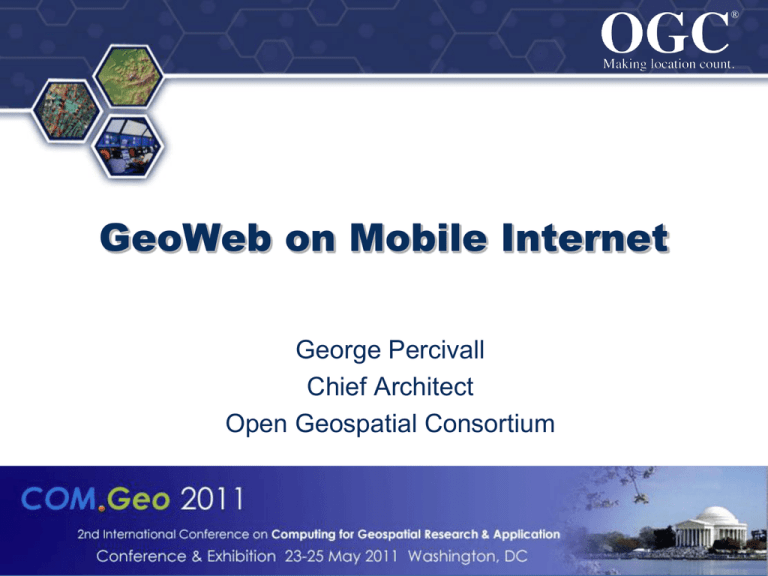
®
®
GeoWeb on Mobile Internet
George Percivall
Chief Architect
Open Geospatial Consortium
© 2011 Open Geospatial Consortium, Inc.
GeoWeb on Mobile Internet
• Geospatial data on web now common and transformative
– Access to information for any location and make plans based on it
– From mapping/navigation to advanced environmental studies
– GeoWeb enabled by open standards
• GeoWeb moving to mobile internet platforms
– Soon, if not already, predominant method to access the Internet.
– Dramatic advances in communications and handheld devices.
• Multiple generations of GeoWeb and Mobile
–
–
–
–
Going beyond initial generation of Location Based Services
Recent social networking based on location
But, its not just about maps, directions and checkin.
Enable augmented understanding of our geospatial reality
OGC
®
© 2011 Open Geospatial Consortium, Inc.
GeoWeb on Mobile Internet
W3C
OGC
Today’s Internet
OGC
®
bSa IETF
OASIS
The emerging Internet of things:
-- indoor/outdoor location
-- sensor webs
-- building information models
-- location apps
-- location marketing
-- smart grid
OGC’s Mobile Internet Standards Initiative
OGC Mobile Initiative
• Location, coordinates and
spatial models
• Mobile communications
• Mobile web development
• Augmented Reality
• Internet of Things
• Sensor Webs
OGC
Today’s Talk
1. Spatial Models and
Navigation
2. Visualization and
Augmented Reality
3. Sensors Webs and
Internet of Things
®
© 2011 Open Geospatial Consortium, Inc.
Evolution of Space Scale in Standards
Small
> 10 Km
Geographic
Scale
OGC
> 100 m
>1m
<1m
Environmenta
l Scale
Vista
Scale
Table
Scale
Large
®
Jiyeong Lee, University of Seoul, 2009 OGC TC/PC Meetings, Mountain View, CA, USA
CityGML - 3D Urban Models
Source: GTA Geoinformatik GmbH, www.gta-geo.de
Source; Thomas Kolbe, Berlin TU
• Urban Planning / Operations
• Emergency Mgt / Response
• Transportation / Routing / Logistics
• Indoor navigation
• Retail Site analysis
• Sustainable / Green Communities
• City Services Management
• Noise abatement
• Telecommunications placement
• Many other uses…
OGC
®
© 2011 Open Geospatial Consortium
Outdoor and Indoor Routing in
OGC Testbed OWS-6
• Network topology for CityGML
• WMS interface
• CityGML dataset for demo scenario
Figure courtesy Hitachi
OGC
OWS-6 Outdoor and Indoor 3D
Routing Services Engineering
Report,
OGC document 09-067r2
®
© 2009, Open Geospatial Consortium, Inc.
7
Requirements and Space-Event Modeling
for Indoor Navigation
• Support for multiple localization methods/infrastructures
– This includes support for arbitrary indoor sensor technologies and their
abstraction, e.g. WiFi, RFID, Bluetooth, or Infrared as well as support for the
ad-hoc selection of technologies used by the portable end-user device.
• Support for different navigation contexts
– The navigation context comprises the type of locomotion, navigation
constraints according to different criteria (e.g.: topographic/geometric
constraints, such as door widths, opening directions of doors, zonal
constraints such as security zones, or temporal access constraints such as
opening hours) and the supported localization technique.
• 3D topographic representation of the interior built environment
– This is required for route planning and derivation of navigable route section from a
model of the indoor built-up space. The representation should avoid duplicating
existing concepts and, thus, should be com- plementary to existing standards like
CityGML, IFC, X3D, ESRI BISDM, etc.
OGC
®
“Requirements and Space-Event Modeling for Indoor Navigation”
Editors: Claus Nagel, Thomas Becker, Robert Kaden, Ki-Joune Li, Jiyeong Lee, Thomas H. Kolbe
OGC 10-191r1 Discussion Paper
© 2011 Open Geospatial Consortium, Inc.
Proposed Indoor Navigation Model
Topology
R3 Geometry
Room 1
GM_Solids
TP_Solids
ISO
19107
WiFi A
Primal
Space
Doors
Euclidean space
embedding of NRS
Floor
(Room 3)
WiFi B
Request for comments on OGC discussion paper:
"Requirements and Space-Event Modeling for Indoor Navigation”
http://www.opengeospatial.org/pressroom/pressreleases/1369
®
© 2011 Open Geospatial Consortium, Inc.
Dual graph
Multilayered Space Model
• UML Model
• XML Schema
Doors
OGC
Dual
Space
ISO 19107
Room 2
Visualization of Geospatial Information
• Web Map Service (WMS)
– Most mature and implemented OGC Web Service standard
• Web Map Tiling Service (WMTS)
– WMS with requests using tiles
• Style Layer Descriptor (SLD) and Symbol Encoding (SE)
– Symbol encodings and request structures for styling WMS
responses
• KML
– Formerly Keyhole Markup Language
• 3D portrayal
– Graphics-based and Image-based
OGC
®
OGC KML
OGC 07-147r2
Open Geospatial Consortium Inc.
Date: 2008-04-14
Reference number of this OGC® project document: OGC
07-147r2
Version: 2.2.0
Category: OGC® Standard
Editor: Tim Wilson
OGC® KML
Copyright © 2007, 2008 Open Geospatial Consortium, Inc. All Rights Reserved.
To obtain additional rights of use, visit http://www.opengeospatial.org/legal/.
Document type:
OGC® Standard
Document subtype:
Encoding
Document stage:
OGC® Standard
Document language:
English
Google contributed KML to become
an open standard for geobrowsers
OGC
®
Copyright © 2010, Open Geospatial Consortium, Inc.
Augmented Reality Markup Language (ARML)
• KML adapted to
Augmented Reality (AR)
• Defined in 2009 with
Wikitude 4
• Proposed by Mobilizy
OGC
ARML to be presented to OGC,
June 2011 meeting by
Martin Lechner, CTO, Mobilizy
®
© 2011 Open Geospatial Consortium, Inc.
OGC 3D Portrayal Interoperability Experiment
#5a/b
WFS
#1
3D
Database
W3DS
Server
Converter
CityGML
Datasets
Other
Datasets
#3
#2b
Optimizer
3D
Database
WVS
Server
#2a
OGC Discussion Papers:
Web 3D Service (W3DS): Graphics-based portrayal service
Web View Service (WVS): Image-based portrayal service
OGC
W3DS Client
Application
WVS Client
Application
#4
#6a/b
®
Website
showing 3D
content
Mobile Apps
Internet of Things
• The Internet of things, also known as the Internet of
objects, refers to the networked interconnection of
everyday objects
(Wikipedia)
• A new era of ubiquity, where
– “Users” of Internet will be counted in billions
– Humans may become the minority as generators and
receivers of traffic.
– Most traffic will flow between devices and all kinds of
“things”, thereby creating a much wider and more
complex Internet of Things.
(From “The Internet of Things”, ITU Internet Report 2005)
OGC
®
© 2011 Open Geospatial Consortium, Inc.
Internet of Things
Connecting our world with accessible networks is
scaling to trillions of everyday objects
• CeNSE, Planetary Skin,
Smarter Planet, others
• The location of all objects
will be known
• Relevant technologies
– IPv6
– Mobile Communications
– NFC – Tags – EPC Global
– Sensor Webs
Stephan Haller, SAP
OGC
®
© 2011 Open Geospatial Consortium, Inc.
OGC Sensor Web Enablement
•
•
•
•
•
•
Industrial
Process
Monitor
Sensors connected to and discoverable on the Web
Sensors have position & generate observations
Sensor descriptions available
Automobile
Services to task and access sensors
As Sensor Probe
Local, regional, national scalability
Enabling the Enterprise
Airborne
Imaging
Device
Traffic
Monitoring
Temp
Sensor
OGC
Satellite-borne
Imaging Device
Stored
Sensor
Data
Webcam
Strain
Gauge
®
Environmental
Monitor
Health
Monitor
16
Sensor Web Enablement - Basic Vision
• Quickly discover sensors and sensor data (secure or
public) that can meet my needs – based on location,
observables, quality, ability to task, etc.
• Obtain sensor information in a standard encoding that is
understandable by my software and enables assessment
and processing without a-priori knowledge
• Readily access sensor observations in a common manner,
and in a form specific to my needs
• Task sensors, when possible, to meet my specific needs
• Subscribe to and receive alerts when a sensor measures a
particular phenomenon
OGC
®
OGC SWE Specifications
• Information Models and Schema
– SWE Common – common data models used throughout SWE specs
– Sensor Model Language (SensorML) - Models and schema for
observation processes: support for sensor components and systems,
geolocation, response models, post measurement processing
– Observations and Measurements (O&M) – Core models and schema for
observations; archived and streaming
• Web Services
– Sensor Observation Service - Access Observations for a sensor or sensor
constellation, and optionally, the associated sensor and platform data
– Sensor Alert Service – Subscribe to alerts based upon sensor
observations
– Sensor Planning Service – Request collection feasibility and task sensor
system for desired observations
• Version 2.0 of SWE Specifications currently being released
OGC
®
Model of a Sensor System
OGC
®
Sensor Web Enablement Architecture, OGC document 06-021r4
http://portal.opengeospatial.org/files/?artifact_id=29405
Copyright © 2007, Open Geospatial Consortium, Inc.,
All Rights Reserved.
Observations and Measurements
• An observation feature binds a result to a feature of interest, upon
which the observation was made
• Observation - act of observing a property or phenomenon, with the goal
of producing an estimate of the value of the property.
• Observations are modeled as Features within the context of the
General Feature Model [ISO 19101, ISO 19109]
OGC
®
Copyright © 2007, Open Geospatial Consortium, Inc.,
All Rights Reserved.
SWE Web Services
Access Sensor
Description and
Data
Command and
Task Sensor
Systems
SOS
Discover Services,
Sensors,
Providers, Data
SPS
SAS
Dispatch Sensor
Alerts to registered
Users
Catalog
Service
OGC
®
Clients
Copyright © 2009, Open Geospatial Consortium, Inc.
Accessible from
various types of
clients from PDAs
and Cell Phones to
high end
Workstations
21
Air quality monitoring pilot
• Emission/imission
modeling in Moulin, Fr
(simple site) and Linz
(complex site; more data
sources)
• Cross border integration
on French/Belgium border
in Flanders
• SANY/SWE compliant
systems
• Managing QA
information within SOS
• Fusion & modelling
services
Air Quality
monitoring
Air quality management
Vendor
independence
Cross-border
monitoring and
alerting
QA automation
SANY-compliant
data acquisition
systems
Other data
sources
SANY infrastructure
services
Added-value Generic Services
Fusion
Services
-temporal
-spatial
-≠kind of data
Modelling
services
- diffusion
- transport
Visualisation
Services
- Colour-coded
maps
- Time series
Debris Flow Monitoring and
Forecast Sensor GRID
Grid
OGC
®
PULSENetTM Applications: Atmospheric/Air Quality – Fire
Monitoring/Smoke Forecasting
Charlie Neuman, San Diego Union-Tribune/Zuma Press
OGC
®
Northrop Grumman PULSENetTM
24
How to build the Internet of Things
Stakeholders…
participate in
cooperating
Standards
Development
Organizations…
OGC
Corporations:
IETF
IT platform providers
Search companies
W3C
Carriers
bSa
Router companies
OASIS
Cell phone manufacturers
IEEE
Sensor companies
IEC
Government agencies/offices
ISO
Non-governmental organizations
ITU
Research centers
etc.
Universities
OGC
®
who manage
rapid standards
prototyping, testing &
deployment activities…
to create an open
standards framework
(interfaces and
encodings) for
connecting with
the real world:
indoor/outdoor location
Testbeds
Interoperability
experiments
Plugfests
Pilot projects
Sensor/actuator
description & control
Observations/measureme
nts
Machine-to-machine
communication
Security & privacy
Publishing & discovery
Rights management
Data provenance, quality,
uncertainty
OGC’s Mobile Internet Standards Initiative
Topics
• Location, coordinates and
spatial models
• Internet of Things
• Mobile development
• Mobile communications
• Sensor Webs
• Augmented Reality
Methods
• COM.Geo Workshop
• Standards Liaisons
• OGC Specification
Program
– Discussion Papers
– Working Groups
– Standards
• OGC Interoperability
Program
– Mobile/IoT Testbed
OGC
®
© 2011 Open Geospatial Consortium, Inc.
For Details on OGC Standards…
• OGC Standards
– Freely available
– www.opengeospatial.org/standards
• OGC Reference Model (ORM)
– Overview of OGC Standards Baseline
– Resource for defining architectures for specific
applications
– www.opengeospatial.org/standards/orm
George Percivall, gpercivall at opengeospatial.org
OGC
®
Copyright © 2010, Open Geospatial Consortium, Inc.

